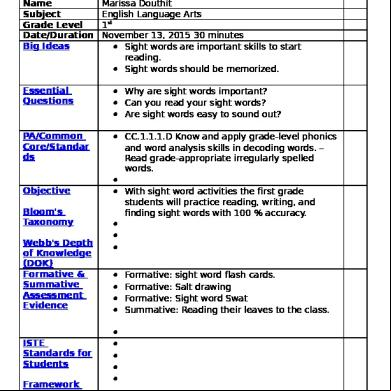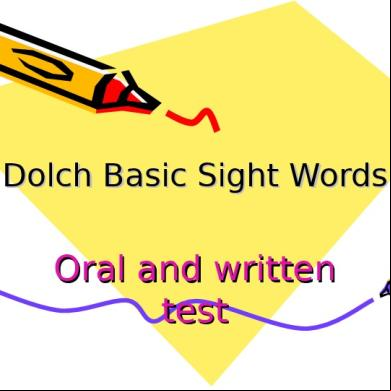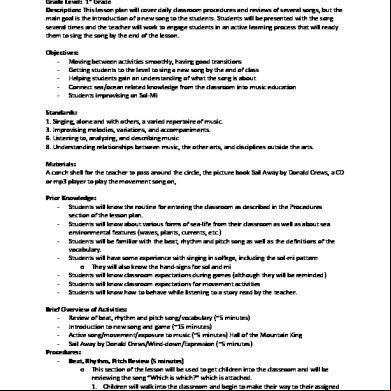1st Grade Sight Words 4w396m
This document was ed by and they confirmed that they have the permission to share it. If you are author or own the copyright of this book, please report to us by using this report form. Report 3b7i
Overview 3e4r5l
& View 1st Grade Sight Words as PDF for free.
More details w3441
- Words: 694
- Pages: 4
SETON HILL UNIVERSITY Lesson Plan Template TOPIC DETAILS Name Marissa Douthit Subject English Language Arts Grade Level 1st Date/Duration November 13, 2015 30 minutes Big Ideas Sight words are important skills to start reading. Sight words should be memorized. Essential Questions
Why are sight words important? Can you read your sight words? Are sight words easy to sound out?
PA/Common Core/Standar ds
CC.1.1.1.D Know and apply grade-level phonics and word analysis skills in decoding words. – Read grade-appropriate irregularly spelled words. With sight word activities the first grade students will practice reading, writing, and finding sight words with 100 % accuracy.
Objective Bloom's Taxonomy Webb's Depth of Knowledge (DOK) Formative & Summative Assessment Evidence
ISTE Standards for Students Framework for 21st Century Learning
Formative: sight word flash cards. Formative: Salt drawing Formative: Sight word Swat Summative: Reading their leaves to the class.
CK
Accommodati ons, Modifications
Reduce the list of sight words I am reviewing. Give small lists of sight words to put on desks.
SUPERVISING TEACHER’S SIGNATURE Seton Hill University Lesson Plan Template Step-by-Step Procedures RATIONALE for the Learning Plan Introduction Activating Prior Knowledge Ask students what a sight word is. Why do we practice sight words? Are sight words easy to sound out? Hook/Lead-In/Anticipatory Set Sight word flash cards. As a class students will read the sight word flash card as I hold it up. Explicit Big Idea Statement Instructions Sight words are important skills to start reading. Sight words should be memorized. Essential Questions Statement Why are sight words important? Can you read your sight words? Objective Statement With multiple sight word activities, the first grade students will practice reading, writing, and finding sight words with 100 % accuracy. Key Vocabulary All sight words Lesson PreAssessment of Students Procedure Salt drawing sight words. Students will be given plates with salt. As I say the word students will write the word in the salt. As students are writing the word they should spell it out loud.
CK
Modeling of the Concept Create a sight word tree. Students will write eight sight words on the leaves of their trees. Words should be words that the student needs extra practice. Guiding the Practice Sight word swat Students will be divided into two groups. They will have a fly swatter and sight words will be spread out on the floor. When the teacher says a sight word the students will race to swat the word first. After they swat the word the student must read the word to the class. Whoever gets the word first wins a point. Providing the Independent Practice In small groups students will play Flip the Egg. Students will have paper eggs with all the sight words on them. Then the student will draw a card from the pile. That student will then read the word the got and look for the egg with the sight word on it. They get will get one chance to find the word. If they find it they get to keep it. Whoever has the most at the end wins. Reading Materials Technology Equipment Supplies
Evaluation of the Learning/Mas tery of the
Sight word flash cards Masking tape Salt Leaves Trees Two Fly swatters Sight word cards for swat Egg sigh words 3 Spatulas Formal Evaluation Students will read their eight sight words from their sight word tree to the class. Informal Evaluation
Concept
Closure
Sight word flash cards. Salt drawing Sight word Swat Summary & Review of the Learning Students will bring their trees to the front of the classroom and read the words on their leaves. Homework/Assignments
Teacher Selfreflection
Practice sight words Challenge students to put their sight word tree on the refrigerator. Before they open the refrigerator they must read their sight words.
Why are sight words important? Can you read your sight words? Are sight words easy to sound out?
PA/Common Core/Standar ds
CC.1.1.1.D Know and apply grade-level phonics and word analysis skills in decoding words. – Read grade-appropriate irregularly spelled words. With sight word activities the first grade students will practice reading, writing, and finding sight words with 100 % accuracy.
Objective Bloom's Taxonomy Webb's Depth of Knowledge (DOK) Formative & Summative Assessment Evidence
ISTE Standards for Students Framework for 21st Century Learning
Formative: sight word flash cards. Formative: Salt drawing Formative: Sight word Swat Summative: Reading their leaves to the class.
CK
Accommodati ons, Modifications
Reduce the list of sight words I am reviewing. Give small lists of sight words to put on desks.
SUPERVISING TEACHER’S SIGNATURE Seton Hill University Lesson Plan Template Step-by-Step Procedures RATIONALE for the Learning Plan Introduction Activating Prior Knowledge Ask students what a sight word is. Why do we practice sight words? Are sight words easy to sound out? Hook/Lead-In/Anticipatory Set Sight word flash cards. As a class students will read the sight word flash card as I hold it up. Explicit Big Idea Statement Instructions Sight words are important skills to start reading. Sight words should be memorized. Essential Questions Statement Why are sight words important? Can you read your sight words? Objective Statement With multiple sight word activities, the first grade students will practice reading, writing, and finding sight words with 100 % accuracy. Key Vocabulary All sight words Lesson PreAssessment of Students Procedure Salt drawing sight words. Students will be given plates with salt. As I say the word students will write the word in the salt. As students are writing the word they should spell it out loud.
CK
Modeling of the Concept Create a sight word tree. Students will write eight sight words on the leaves of their trees. Words should be words that the student needs extra practice. Guiding the Practice Sight word swat Students will be divided into two groups. They will have a fly swatter and sight words will be spread out on the floor. When the teacher says a sight word the students will race to swat the word first. After they swat the word the student must read the word to the class. Whoever gets the word first wins a point. Providing the Independent Practice In small groups students will play Flip the Egg. Students will have paper eggs with all the sight words on them. Then the student will draw a card from the pile. That student will then read the word the got and look for the egg with the sight word on it. They get will get one chance to find the word. If they find it they get to keep it. Whoever has the most at the end wins. Reading Materials Technology Equipment Supplies
Evaluation of the Learning/Mas tery of the
Sight word flash cards Masking tape Salt Leaves Trees Two Fly swatters Sight word cards for swat Egg sigh words 3 Spatulas Formal Evaluation Students will read their eight sight words from their sight word tree to the class. Informal Evaluation
Concept
Closure
Sight word flash cards. Salt drawing Sight word Swat Summary & Review of the Learning Students will bring their trees to the front of the classroom and read the words on their leaves. Homework/Assignments
Teacher Selfreflection
Practice sight words Challenge students to put their sight word tree on the refrigerator. Before they open the refrigerator they must read their sight words.





